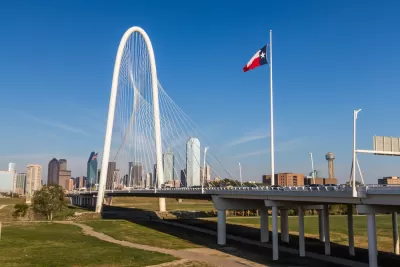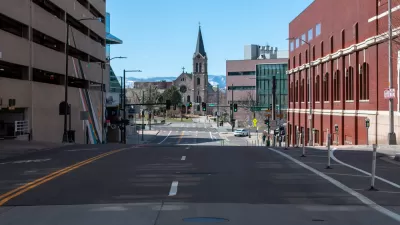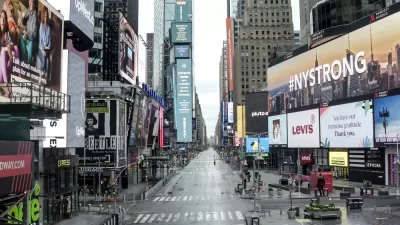Dallasites have a history of responding to times of crisis with plans for reinvention. What could the city do to improve public life after the coronavirus pandemic?

Dallas isn't known for being a particularly walkable city. Lockdown has brought more people into the streets, seeking solace in exercise and a reminder of social life in public spaces.
Mark Lamster envisions a future where this newfound fervor for pedestrianism reshapes the city: "When lockdown ends, and it will, our streets will reopen. But instead of returning them to the status quo ante, why not take this opportunity to rapidly paint in bike lanes and adapt our streets to better suit the needs of pedestrians. That means expanding sidewalks, squaring off those infernal 'radiused' corners — the corners rounded off to allow cars to turn faster — creating median strips and bump outs at crossings, and many other proven traffic calming techniques."
Building a stronger Dallas begins with modifying the streets, removing I-345, and creating additional pedestrian-friendly infrastructure, persuades Lamster pointing to Klyde Warren Park as a proof of concept.
What else can Dallasites do to improve urban infrastructure after the passing of the pandemic? Dallas could design public infrastructure with the concept of dual-use facilities in mind. Resilience planners are calling for flexible use of public buildings like the Kay Bailey Hutchison Convention Center, which was recently converted into a medical center to facilitate increased demand for medical care.
In Lamster's view, Dallas has two options: "better or worse for it, better prepared for the next disaster, or more susceptible than it is even now."
FULL STORY: With the coronavirus, an opportunity to reinvent Dallas

Alabama: Trump Terminates Settlements for Black Communities Harmed By Raw Sewage
Trump deemed the landmark civil rights agreement “illegal DEI and environmental justice policy.”

Study: Maui’s Plan to Convert Vacation Rentals to Long-Term Housing Could Cause Nearly $1 Billion Economic Loss
The plan would reduce visitor accommodation by 25% resulting in 1,900 jobs lost.

Why Should We Subsidize Public Transportation?
Many public transit agencies face financial stress due to rising costs, declining fare revenue, and declining subsidies. Transit advocates must provide a strong business case for increasing public transit funding.

Paris Bike Boom Leads to Steep Drop in Air Pollution
The French city’s air quality has improved dramatically in the past 20 years, coinciding with a growth in cycling.

Why Housing Costs More to Build in California Than in Texas
Hard costs like labor and materials combined with ‘soft’ costs such as permitting make building in the San Francisco Bay Area almost three times as costly as in Texas cities.

San Diego County Sees a Rise in Urban Coyotes
San Diego County experiences a rise in urban coyotes, as sightings become prevalent throughout its urban neighbourhoods and surrounding areas.
Urban Design for Planners 1: Software Tools
This six-course series explores essential urban design concepts using open source software and equips planners with the tools they need to participate fully in the urban design process.
Planning for Universal Design
Learn the tools for implementing Universal Design in planning regulations.
Smith Gee Studio
Alamo Area Metropolitan Planning Organization
City of Santa Clarita
Institute for Housing and Urban Development Studies (IHS)
City of Grandview
Harvard GSD Executive Education
Toledo-Lucas County Plan Commissions
Salt Lake City
NYU Wagner Graduate School of Public Service





























